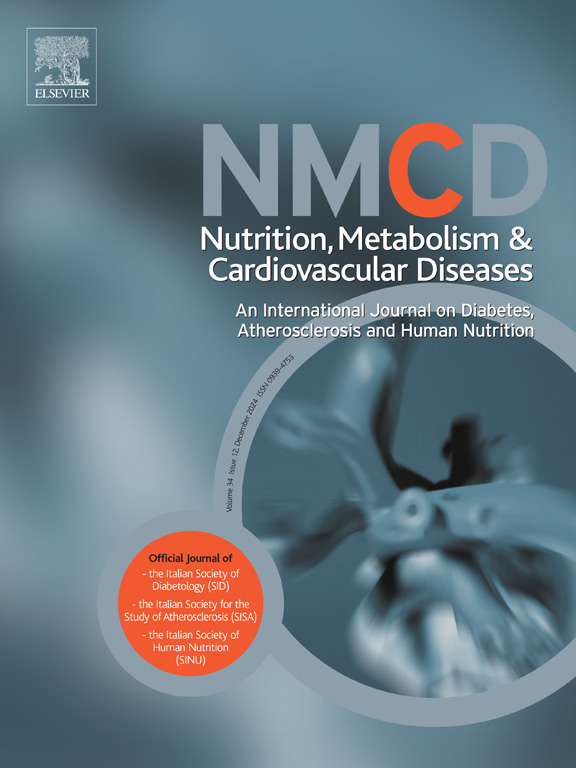Associations of plasma arginine, homoarginine, and ADMA/SDMA levels with risk of ischemic stroke: A nested case-control study
IF 3.3
3区 医学
Q2 CARDIAC & CARDIOVASCULAR SYSTEMS
Nutrition Metabolism and Cardiovascular Diseases
Pub Date : 2025-02-01
DOI:10.1016/j.numecd.2024.08.005
引用次数: 0
Abstract
Background and aims
Previous studies have linked aberrant nitric oxide (NO) metabolism with vascular diseases. Although arginine, homoarginine, asymmetric dimethylarginine (ADMA), and symmetric dimethylarginine (SDMA) are involved in NO metabolic pathways, their associations with ischemic stroke (IS) remain unclear.
Methods and results
We conducted a case-control study nested within the Prospective Follow-up Study on Cardiovascular Morbidity and Mortality in China (PFS-CMMC) (2013–2018, n = 16,457; median follow-up time: 5.3 y), which included 321 incident cases of IS and 321 controls matched by age and sex. Plasma arginine, homoarginine, ADMA/SDMA were measured by ultrahigh performance liquid chromatography-tandem mass spectrometry. Conditional logistic regression analyses were used to calculate odds ratios (ORs) and their 95% confidence intervals (CIs) for the association between the plasma metabolites and IS risk.
After adjustment for body mass index, educational attainment, smoking, hypertension, hyperlipidemia, diabetes, and family history of stroke, the OR of IS risk for the highest versus the lowest quartile was 2.46 (95% CI: 1.39–4.35, P trend = 0.004) for homoarginine and 2.22 (95% CI: 1.24–3.97, P trend = 0.003) for ADMA/SDMA. Spline regression analyses indicated positive dose-response relationships of homoarginine and ADMA/SDMA with the IS risk (both P for linearity <0.05). No significant association was observed between plasma arginine and IS risk.
Conclusions
Elevated plasma levels of homoarginine and ADMA/SDMA were associated with a higher risk of IS. Our novel findings suggest a role of NO metabolism in the pathogenesis of IS.
血浆精氨酸、同精氨酸和 ADMA/SDMA 水平与缺血性中风风险的关系:巢式病例对照研究
以往的研究表明,一氧化氮(NO)代谢异常与血管疾病有关。虽然精氨酸、高精氨酸、不对称二甲基精氨酸(ADMA)和对称二甲基精氨酸(SDMA)参与了一氧化氮的代谢途径,但它们与缺血性脑卒中(IS)的关系仍不清楚。我们在中国心血管病发病率和死亡率前瞻性随访研究(PFS-CMMC)(2013-2018 年,n = 16,457; 中位随访时间:5.3 年)中嵌套了一项病例对照研究,其中包括 321 例 IS 发病病例和 321 例年龄和性别匹配的对照病例。血浆精氨酸、高精氨酸、ADMA/SDMA 采用超高效液相色谱-串联质谱法进行测定。条件逻辑回归分析用于计算血浆代谢物与 IS 风险之间的几率比(ORs)及其 95% 置信区间(CIs)。高精氨酸和 ADMA/SDMA 的血浆水平升高与较高的 IS 风险相关。我们的新发现表明,氮氧化物代谢在IS的发病机制中起着重要作用。
本文章由计算机程序翻译,如有差异,请以英文原文为准。
求助全文
约1分钟内获得全文
求助全文
来源期刊
CiteScore
6.80
自引率
2.60%
发文量
332
审稿时长
57 days
期刊介绍:
Nutrition, Metabolism & Cardiovascular Diseases is a forum designed to focus on the powerful interplay between nutritional and metabolic alterations, and cardiovascular disorders. It aims to be a highly qualified tool to help refine strategies against the nutrition-related epidemics of metabolic and cardiovascular diseases. By presenting original clinical and experimental findings, it introduces readers and authors into a rapidly developing area of clinical and preventive medicine, including also vascular biology. Of particular concern are the origins, the mechanisms and the means to prevent and control diabetes, atherosclerosis, hypertension, and other nutrition-related diseases.

 求助内容:
求助内容: 应助结果提醒方式:
应助结果提醒方式:


